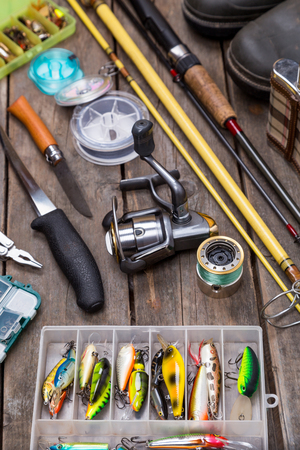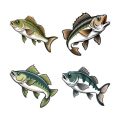The Essentials: What Belongs in Your Tackle Box?
Every American angler knows that a well-organized tackle box is the secret weapon for landing more fish and staying prepared on the water. Whether you’re casting from a quiet lake dock or trekking along wild riverbanks, having your gear dialed in makes all the difference. Let’s break down the must-have items every pro keeps in their tackle box.
Lures, Baits, and Hooks
Variety is key because you never know what the fish will bite on any given day. Here’s a quick guide to the basics:
| Lure Type | Best For |
|---|---|
| Soft Plastics (Worms, Craws) | Bass, Panfish |
| Crankbaits | Bass, Pike, Walleye |
| Spinnerbaits | Murky Water |
| Spoons | Trout, Salmon |
- Packs of assorted hooks (sizes 1/0 to 6 for versatility)
- Weights and sinkers for different water conditions
Tackle Tools and Accessories
- Pliers (for hook removal and crimping split shot)
- Nail clippers or line cutters
- Small knife or multi-tool
Terminal Tackle
- Extra fishing line or leader material (monofilament and fluorocarbon)
- Swivels, snaps, bobbers, and floats
First-Aid Basics
No one plans on getting hooked—or sunburnt—but it happens. Smart anglers always carry:
- Bandaids and antiseptic wipes
- Sunscreen (travel size)
- Bug spray packets
Other Handy Items
- Small flashlight or headlamp (for those early mornings or late nights)
- Tape measure for brag-worthy catches
- Ziploc bags for keeping things dry or taking home your catch fillets
Tackle Box Packing Tip:
Keep your most-used gear up top, and stash backup supplies underneath. This saves time when the action heats up!
2. Smart Organization: How Pros Keep Their Gear Sorted
Why Tackle Box Organization Matters
If you want to fish like a pro, the first step is keeping your tackle box organized. A well-sorted tackle box means less time digging for gear and more time casting your line. Professional anglers know every second counts—especially when the fish are biting.
Compartment Use: Divide and Conquer
Most tackle boxes come with adjustable compartments. Use these to separate your lures, hooks, sinkers, and bobbers. Keeping similar items together not only saves time but also protects delicate gear from damage.
| Compartment | What to Store |
|---|---|
| Small Compartments | Hooks, swivels, split shot weights |
| Medium Compartments | Lures, soft plastics, small tools |
| Large Compartments | Spools of line, pliers, leader material |
Labeling: Know What’s Where at a Glance
A simple label maker or even masking tape and a marker can turn your tackle box into an efficient system. Label each compartment by type or size (for example, “Jigs – 1/8 oz” or “Worm Hooks – 2/0”). This saves you from rummaging around when you need something fast.
Pro Tip:
Color-code your labels for different species or fishing styles. For instance, use blue labels for bass tackle and green for trout gear.
Storing Essentials for Quick Access
The best anglers keep their most-used gear in easy-to-reach spots. Store pliers, scissors, and frequently used lures near the top or in side pockets. Reserve hard-to-reach areas for backup supplies or specialty baits you don’t use as often.
Packing Order Example:
| Layer/Section | Items to Store |
|---|---|
| Top Layer/Pocket | Pliers, scissors, go-to lures, sunscreen |
| Main Compartments | Lures sorted by type & size, extra hooks, weights |
| Bottom Layer/Hidden Pockets | First aid kit, backup line spools, specialty rigs |
Stay Flexible: Reorganize When Needed
Your fishing needs will change depending on the season and location. Don’t be afraid to reorganize your tackle box before each trip. The pros do it all the time to stay prepared for whatever bites next!

3. The Right Box for the Job: Choosing Your Tackle Box Style
When it comes to organizing your fishing gear, picking the right tackle box can make or break your day on the water. Across the U.S., anglers have their own favorites, shaped by local traditions, fishing styles, and what just plain works. Let’s break down some of the most popular tackle box styles you’ll see at American lakes, rivers, and coastlines—and when to use each one.
Classic Tray Tackle Boxes
This is the old-school favorite—the classic hard plastic box with fold-out trays. If you grew up fishing with your dad or granddad, you probably remember seeing one of these packed full of lures and bobbers. They’re sturdy, easy to organize, and great for beginners or casual anglers who don’t need a ton of specialized gear.
Best For:
- Bank fishing trips
- Pond hopping
- Kids learning the ropes
Soft-Sided Tackle Bags
Soft-sided bags are like the Swiss Army knife of tackle storage. They come with multiple zippered pockets and removable plastic trays. These are lighter than hard boxes and easier to carry—great for folks who like to walk the shoreline or hike into secret spots.
Best For:
- Bass fishing tournaments
- Urban anglers on the move
- Kayak or canoe trips
Modular Backpacks
If you want to keep your hands free, a modular tackle backpack might be your best friend. Designed for maximum mobility, these packs hold a surprising amount of gear and often include space for water bottles, tools, and even rain jackets. Some models feature built-in rod holders—perfect for hiking deep into public lands or reaching remote creeks.
Best For:
- Backcountry fishing adventures
- Traveling light and fast
- Anglers who fish on foot all day
Tackle Boxes at a Glance
| Tackle Box Style | Main Features | Best Use Case |
|---|---|---|
| Classic Tray Box | Hard shell, fold-out trays, durable build | Causal fishing trips; easy organization for beginners |
| Soft-Sided Bag | Zippered pockets, lightweight, removable trays | Bass tournaments; mobile bank anglers; kayak fishing |
| Modular Backpack | Padded straps, multi-use compartments, hands-free carry | Hiking to remote spots; long days on foot; backcountry trips |
Pro Tip:
The best tackle box is the one that matches your style of fishing—and how much gear you really need to carry. Don’t overpack if you’re going mobile, but bring enough options so you’re ready for anything Mother Nature throws your way.
4. Weatherproof Your Gear: Staying Ready for Anything
When you’re out fishing or adventuring in the great American outdoors, weather can change in a heartbeat. Rain showers, morning dew, high humidity, and even dusty winds can mess with your tackle box and gear if you’re not prepared. Here’s how to keep your tackle organized and protected no matter what Mother Nature throws at you.
Choose the Right Tackle Box Materials
Start by picking a tackle box made from sturdy, weather-resistant materials. Look for boxes with tight-sealing lids and rust-proof hardware. Some brands even offer waterproof gaskets to keep moisture out. Here’s a quick comparison of common tackle box materials:
| Material | Weather Resistance | Durability | Notes |
|---|---|---|---|
| Plastic (Polypropylene) | High (water-resistant) | Good | Lightweight; won’t rust |
| Metal (Aluminum) | Medium (can corrode) | Excellent | Tough but needs care against moisture |
| Waterproof Soft Bags | High (with sealed zippers) | Varies by brand | Flexible and easy to pack |
Packing Strategies to Beat the Elements
- Use Waterproof Compartments: Store sensitive items like electronics, licenses, and first-aid supplies in waterproof pouches inside your tackle box.
- Add Silica Gel Packs: Toss in a few silica gel packets to absorb excess moisture and prevent rust on hooks and lures.
- Double Bag Small Items: Place terminal tackle or soft plastics in resealable plastic bags before organizing them into trays.
- Avoid Overpacking: Leave space for air circulation so humidity doesn’t get trapped inside your box.
On-the-Go Protection Tips
- Cover Up Fast: Keep a small tarp or waterproof cover handy for sudden downpours. Throw it over your gear when the clouds roll in.
- Ditch Wet Gear Promptly: If something gets soaked, dry it out as soon as possible to avoid mildew and corrosion.
- Store Off the Ground: Set your tackle box on a rock, stump, or camp chair instead of dirt or wet grass to keep it clean and dry.
Your Go-To Weatherproofing Checklist:
- Tight-seal tackle box with rust-proof latches
- Pouches or cases for valuables (phone, papers, etc.)
- Silica gel packs or anti-rust tabs inside compartments
- Tarp or rain cover stashed in an outside pocket
- Spares of important gear in case something gets soaked
Tough Weather? No Sweat!
If you organize smart and prep your gear for whatever weather comes along, you’ll spend less time worrying about soggy hooks or rusty pliers—and more time enjoying your adventure. Stay ready for anything and let the fish be the only thing getting wet!
5. DIY Hacks: Custom Mods and American-Made Add-Ons
Get Creative with Your Tackle Box
If you’ve ever fished alongside seasoned U.S. anglers, you’ll know no two tackle boxes are ever the same. American fishers love to tinker, personalize, and upgrade their gear for max efficiency and personal flair. Here’s how you can level up your own tackle box with clever DIY hacks and top-quality, made-in-the-USA add-ons.
Popular DIY Modifications
| DIY Hack | Description | Why Anglers Love It |
|---|---|---|
| Foam Insert Trays | Cut foam to fit compartments, then slice slits for lures and hooks. | Keeps sharp items secure and easy to grab. |
| Magnetic Strips | Attach magnetic tape inside the lid or base. | Stops small metal gear from rolling around or getting lost. |
| Pill Organizer Boxes | Repurpose weekly pill boxes for tiny terminal tackle. | Makes swapping out weights or swivels a breeze. |
| Coffee Can Line Holder | Use a plastic coffee canister for storing extra fishing line spools. | Budget-friendly and keeps line tangle-free. |
| Duct Tape Fixes | Add duct tape patches for emergency repairs or quick fixes on the go. | Classic American ingenuity—never go without it! |
American-Made Add-Ons Worth Checking Out
- Plano Tackle Box Accessories: Plano is an iconic U.S. brand offering everything from extra dividers to utility boxes that slot right into your main tackle box system.
- Berkley Bait Management Tools: Berkley’s made-in-America jar holders and scent-proof bait bags keep things organized and fresh—just what you need when chasing bass or trout.
- Waterproof Storage Pouches: Brands like Flambeau Outdoors offer heavy-duty, water-resistant pouches for phones, licenses, or sensitive gear.
- Lure Wraps & Sleeves: Grab custom-made lure wraps (often sold at local American tackle shops) to prevent tangles between crankbaits and spinnerbaits.
- Tackle Labels: Use weatherproof stickers (many available from small U.S. businesses on Etsy) to mark compartments by bait type or target species. Makes finding what you need lightning fast!
Pro Tip: Mix Store-Bought with Homemade Mods
The best setups often combine store-bought upgrades with good old-fashioned DIY creativity. Don’t be afraid to experiment—after all, that’s the spirit of American angling! Whether you’re adding a custom foam insert or snapping in a new divider, your tackle box should work as hard as you do out on the water.
6. Quick Grab List: Don’t Leave Home Without These
If you’ve ever shown up at your favorite fishing spot and realized you forgot something crucial, you’re not alone. Even seasoned anglers sometimes leave behind essential gear. Here’s a practical checklist of the most commonly forgotten—but totally necessary—items American fishers swear by. Keep this quick grab list handy so your tackle box is always ready for action.
Most Forgotten, Must-Have Tackle Box Items
| Item | Why You Need It |
|---|---|
| Pliers or Multi-tool | For removing hooks, cutting line, quick fixes, and more. |
| Extra Line | Break-offs happen—always bring backup line in the right weight. |
| Leader Material | Essential for picky fish or toothy critters like pike and muskie. |
| Small First Aid Kit | Cuts and scrapes are common; don’t get sidelined by a minor injury. |
| Sunscreen & Bug Spray | The sun and bugs can ruin a trip fast—be prepared! |
| Knife or Line Cutter | You’ll need it for bait prep, tangled lines, or emergencies. |
| Hook Sharpener | Dull hooks miss fish—keep yours razor-sharp on the go. |
| Split Shot & Extra Weights | Conditions change; adjust your rig easily when needed. |
| Small Flashlight or Headlamp | If you fish early mornings or late evenings, don’t get caught in the dark. |
| Fishing License (in a Waterproof Case) | A must-have to stay legal—always double-check before leaving home. |
| Ziploc Bags or Small Containers | Keep soft plastics organized or stash snacks, trash, or wet items. |
| Towel or Rag | For cleaning hands after baiting hooks or handling fish. |
| Super Glue or Electrical Tape | Quick fixes for lures, rods, sunglasses, or even minor wounds. |
Packing Tips from American Anglers:
- Create a “go bag”: Keep these essentials together so you can grab and head out without second-guessing what’s missing.
- Restock after every trip: If you use something up (like extra hooks or sunscreen), replace it right away so your box stays ready for next time.
- Laminated checklist: Tape a small waterproof checklist inside your tackle box lid for last-minute double-checks before every trip.
Your Next Adventure Starts with a Well-Packed Box!
A little planning goes a long way. With this quick grab list, you’ll be organized like a pro—and never have to turn back for that one thing again.


